THE PROMEGRANATE

compiled by Dee Finney
| Pomegranate | |
|---|---|
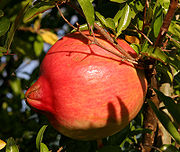 | |
| Fruit of pomegranate | |
| Scientific classification | |
| Kingdom: | Plantae |
| Division: | Magnoliophyta |
| Class: | Magnoliopsida |
| Subclass: | Rosidae |
| Order: | Myrtales |
| Family: | Lythraceae |
| Genus: | Punica |
| Species: | P. granatum |
| Binomial name | |
| Punica granatum L. | |
| Synonyms | |
Linnaeus, 1758 | |
The pomegranate, Punica granatum) is a fruit-bearing deciduous shrub or small tree growing to between five and eight meters tall. The pomegranate is native to Southwest Asia and has been cultivated in the Caucasus since ancient times. It is widely cultivated throughout Armenia, Azerbaijan, Iran, Turkey, the drier parts of southeast Asia, Peninsular Malaysia, the East Indies, and tropical Africa.[1] Introduced into Latin America and California by Spanish settlers in 1769, pomegranate is now cultivated in parts of California and Arizona for juice production.[2]
In the Northern Hemisphere, the fruit is typically in season from September to February.[3] In the Southern Hemisphere, it is in season from March to May.
About 760 different local varieties of pomegranate have been recognized in Iran[4]. These varieties have been collected in Agricultural Research Institute, Yazd, Iran. The most famous varieties are Soveh, Sioh, Rabob, Aghaei, Ardestony, Shisheh cap, Shirin Shahvor, Bajestony, Malas e Daneh Siah, Touq Gardan, Khazar, Shecar e Ashraf (Behshahr), Alak, Arous, Farouq, Rahab, Khafar e Shiraz, Ferdous e Khorasan, Bi daneh Sangan.
Foliage and fruit
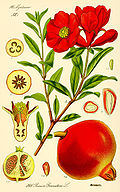
The leaves are opposite or sub-opposite, glossy, narrow oblong, entire, 3–7 cm long and 2 cm broad. The flowers are bright red, 3 cm in diameter, with four to five petals (often more on cultivated plants). Some fruitless varieties are grown for the flowers alone. The edible fruit is a berry and is between a lemon and a grapefruit in size, 5–12 cm in diameter with a rounded hexagonal shape, and has thick reddish skin and around 600 seeds.[5] The seeds and surrounding pulp, ranging in color from white to deep red, are called arils. There are some cultivars which have been introduced that have a range of pulp colors such as purple.
Punica granatum nana is a dwarf variety of P. granatum popularly used as Bonsai trees and as a patio plant. The only other species in the genus Punica is the Socotran pomegranate (Punica protopunica), which is endemic to the island of Socotra. It differs in having pink (not red) flowers and smaller, less sweet fruit. Pomegranates are drought-tolerant, and can be grown in dry areas with either a Mediterranean winter rainfall climate or in summer rainfall climates. In wetter areas, they are prone to root decay from fungal diseases. They are tolerant of moderate frost, down to about −10°C (14°F).[citation needed]
Etymology
| Nutritional value per 100 g (3.5 oz) | ||||||||||||||||||||||||||||||||||||
|---|---|---|---|---|---|---|---|---|---|---|---|---|---|---|---|---|---|---|---|---|---|---|---|---|---|---|---|---|---|---|---|---|---|---|---|---|
| Energy 70 kcal 290 kJ | ||||||||||||||||||||||||||||||||||||
| ||||||||||||||||||||||||||||||||||||
| Percentages are relative to US recommendations for adults. Source: USDA Nutrient database | ||||||||||||||||||||||||||||||||||||
The name "pomegranate" derives from Latin pomum ("apple") and granatus ("seeded"). This has influenced the common name for pomegranate in many languages (e.g., German Granatapfel, seeded apple). In early English, the Pomegranate was known as "apple of Grenada" -- a term which today survives only in heraldic blazons. This was probably a folk etymology, confusing Latin granatus with the Spanish city of Granada. The genus name Punica is named for the Phoenicians, who were active in broadening its cultivation, partly for religious reasons. In classical Latin, where "malum" was broadly applied to many apple-like fruits, the pomegranate's name was malum punicum or malum granatum, the latter giving rise to the Italian name melograno, or less commonly melagrana.
A widespread root for "pomegranate" comes from the Ancient Egyptian rmn, from which derive the Hebrew rimmôn, and Arabic rummân. This root was given by Arabs to other languages, including Portuguese (romã),[6] Kabyle rrumman and Maltese "rummien". The pomegranate ('rimmôn') is mentioned in the Bible as one of the seven fruits/plants that Israel was blessed with, and in Hebrew, 'rimmôn' is also the name of the weapon now called the grenade. According to Webster's New Spanish-English Dictionary, "granada," the Spanish word for "pomegranate," could also mean "grenade." According to the OED, the word "grenade" originated about 1532 from the French name for the pomegranate, la grenade. La grenade also gives us the word grenadine, the name of a kind of fruit syrup, originally made from pomegranates, which is widely used as a cordial and in cocktails.
Origin, cultivation and uses
The pomegranate is native to the region of Persia and has been cultivated in Iran, Armenia, Azerbaijan, Georgia, and the Mediterranean region for several millennia.[7]
In Armenia, Azerbaijan, Georgia, there are wild pomegranate groves outside of ancient abandoned settlements. The cultivation of the pomegranate has a long history in Transcaucasia where decayed remains of pomegranates dating back to 1000 BC have been found. The Kur-Araz lowland is the largest area in this region where pomegranate is cultivated. Carbonized exocarp of the fruit has been identified in Early Bronze Age levels of Jericho, as well as Late Bronze Age levels of Hala Sultan Tekke on Cyprus and Tiryns[citation needed]. A large, dry pomegranate was found in the tomb of Djehuty, the butler of Queen Hatshepsut; Mesopotamian cuneiform records mention pomegranates from the mid-Third millennium BC onwards.[8] It is also extensively grown in South China and in Southeast Asia, whether originally spread along the route of the Silk Road or brought by sea traders.
The ancient city of Granada in Spain was renamed after the fruit during the Moorish period. Spanish colonists later introduced the fruit to the Caribbean and Latin America, but in the English colonies it was less at home: "Don't use the pomegranate inhospitably, a stranger that has come so far to pay his respects to thee," the English Quaker Peter Collinson wrote to the botanizing John Bartram in Philadelphia, 1762. "Plant it against the side of thy house, nail it close to the wall. In this manner it thrives wonderfully with us, and flowers beautifully, and bears fruit this hot year. I have twenty-four on one tree... Doctor Fothergill says, of all trees this is most salutiferous to mankind."[9] The pomegranate had been introduced as an exotic to England the previous century, by John Tradescant the elder, but the disappointment that it did not set fruit there led to its repeated introduction to the American colonies, even New England. It succeeded in the South: Bartram received a barrel of pomegranates and oranges from a correspondent in Charleston, South Carolina, 1764. Thomas Jefferson planted pomegranates at Monticello in 1771: he had them from George Wythe of Williamsburg.[10]
Insect pests of the pomegranate include the pomegranate butterfly Virachola isocrates and the leaf-footed bug Leptoglossus zonatus.
Culinary use
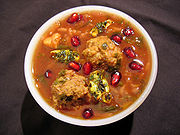
After opening the pomegranate by scoring it with a knife and breaking it open, the arils (seed casings) are separated from the peel and internal white pulp membranes. Separating the red arils is simplified by performing this task in a bowl of water, wherein arils sink and pulp floats. It is also possible to freeze the whole fruit in the freezer, making the red arils easy to separate from the white pulp membranes. The entire seed is consumed raw, though the watery, tasty aril is the desired part. The taste differs depending on subspecies of pomegranate and its ripeness. The pomegranate juice can be very sweet or sour, but most fruits are moderate in taste, with sour notes from the acidic tannins contained in the aril juice.
Having begun wide distribution in the United States and Canada in 2002, pomegranate juice has long been a popular drink in Middle Eastern and Indian cuisine, India.[11]
Grenadine syrup is thickened and sweetened pomegranate juice used in cocktail mixing. Before tomato arrived in the Middle East, grenadine was widely used in many Iranian foods and is still found in traditional recipes such as fesenjan, a thick sauce made from pomegranate juice and ground walnuts, usually spooned over duck or other poultry and rice, and in ash-e anar (pomegranate soup).[12]
Wild pomegranate seeds are sometimes used as a spice known as anardana (which literally means pomegranate (anar) seeds (dana) in Persian), most notably in Indian and Pakistani cuisine but also as a replacement for pomegranate syrup in Middle Eastern cuisine. As a result of this, the dried whole seeds can often be obtained in ethnic Indian Sub-continent markets. The seeds are separated from the flesh, dried for 10–15 days and used as an acidic agent for chutney and curry production. Seeds may also be ground in order to avoid becoming stuck in teeth when eating dishes containing them. Seeds of the wild pomegranate daru from the Himalayas are regarded as quality sources for this spice.
In the Caucasus, pomegranate is used mainly as juice.[13] In Azerbaijan a sauce from pomegranate juice (narsharab) is usually served with fish[14] or tika kabab. In Turkey, pomegranate sauce, (Turkish: nar ekşisi) is used as a salad dressing, to marinate meat, or simply to drink straight. Pomegranate seeds are also used in salads and sometimes as garnish for desserts such as güllaç.[15] Pomegranate syrup or molasses is used in muhammara, a roasted red pepper, walnut, and garlic spread popular in Syria and Turkey.[16] Pomegranate wine is produced in Israel[17] and Armenia.[18]
In Greece, pomegranate (Greek: ρόδι, rodi) is used in many recipes, including kollivozoumi, a creamy broth made from boiled wheat, pomegranates and raisins, legume salad with wheat and pomegranate, traditional Middle Eastern lamb kebabs with pomegranate glaze, pomegranate eggplant relish, and avocado-pomegranate dip. Pomegranate is also made into a liqueur and popular fruit confectionery used as ice cream topping or mixed with yogurt or spread as jam on toast. In Cyprus as well as in Greece and among the Greek Orthodox Diaspora , ρόδι is used to make kolliva, a mixture of wheat, pomegranate seeds, sugar, almonds and other seeds served at memorial services.
[edit] Nutrients and phytochemicals
Pomegranate aril juice provides about 16% of an adult's daily vitamin C requirement per 100 ml serving, and is a good source of vitamin B5 (pantothenic acid), potassium and antioxidant polyphenols.[19]
The most abundant polyphenols in pomegranate juice are the hydrolyzable tannins called punicalagins which have free-radical scavenging properties in laboratory experiments. Punicalagins are absorbed into the human body and may have dietary value as antioxidants, but conclusive proof of efficacy in humans has not yet been shown.[20][21]
Other phytochemicals include polyphenols catechins, gallocatechins, and anthocyanins such as prodelphinidins, delphinidin, cyanidin, and pelargonidin.[22] The ORAC (antioxidant capacity) of pomegranate juice was measured at 2,860 units per 100 grams.[23]
Many food and dietary supplement makers have found advantages of using pomegranate phenolic extracts as ingredients in their products instead of the juice. One of these extracts is ellagic acid which may become bioavailable only after parent molecule punicalagins are metabolized. However, ingested ellagic acid from pomegranate juice does not accumulate in the blood in significant quantities and is rapidly excreted.[24] Accordingly, ellagic acid from pomegranate juice does not appear to be biologically important in vivo.
Potential health benefits
As with many fruits and vegetables, great claims have been made for the health-giving properties of the pomegranate, and some of these claims are backed by studies. However, very few of these studies are conducted on humans in a properly controlled, randomised, double blind manner. Most studies are conducted in vitro, meaning in a test tube. These studies in no way imply that the same effect will be seen from eating the fruit. Some of the studies are detailed below.
In preliminary laboratory research and human pilot studies, juice of the pomegranate was effective in reducing heart disease risk factors, including LDL oxidation, macrophage oxidative status, and foam cell formation,[25][26][27] all of which are steps in atherosclerosis and cardiovascular disease.
Pomegranate juice has also been shown to reduce systolic blood pressure by inhibiting serum angiotensin-converting enzyme,[28] may inhibit viral infections,[29] and may have antibacterial effects against dental plaque.[30]
While one study showed that, in a test tube, extracts of the fruit can inhibit the proliferation of human breast cancer cells[31], no studies have shown that eating pomegranates has any effect on the development of breast cancer in humans.
Pomegranates are listed as high-fiber in charts of nutritional value. That fiber, as well as the unsaturated fat they offer, is mostly contained in the seeds. People who choose to discard the seeds forfeit most of the benefits conveyed by the fiber and fat.
[edit] Clinical trial rationale and activity
Metabolites of pomegranate juice ellagitannins localize specifically in the prostate gland, colon, and intestinal tissues of mice,[32] leading to clinical studies of pomegranate juice or fruit extracts for efficacy against several diseases.
In 2008, 17 clinical trials were underway to examine the effects of pomegranate juice consumption on diseases shown below[33]
- prostate cancer
- prostatic hyperplasia
- diabetes
- lymphoma
- rhinovirus infection (completed, July 2008)
- common cold (completed, June, 2007)
- oxidative stress in hemodialysis
- atherosclerosis
- coronary artery disease (completed, September, 2005)
Symbolism
Judaism
Exodus 28:33–34 directed that images of pomegranates be woven onto the hem of the me'il ("robe of the ephod"), a robe worn by the Hebrew High Priest. 1 Kings 7:13–22 describes pomegranates depicted on the capitals of the two pillars (Jachin and Boaz) which stood in front of the temple King Solomon built in Jerusalem. It is said that Solomon designed his coronet based on the pomegranate's "crown" (calyx).[34] Jewish tradition teaches that the pomegranate is a symbol for righteousness, because it is said to have 613 seeds which corresponds with the 613 mitzvot or commandments of the Torah. For this reason and others, many Jews eat pomegranates on Rosh Hashanah. However, the actual number of seeds varies with individual fruits.[35] It is also a symbol of fruitfulness.[36] The pomegranate is one of the few images which appear on ancient coins of Judea as a holy symbol, and today many Torah scrolls are stored while not in use with a pair of decorative hollow silver "pomegranates" (rimmonim) placed over the two upper scroll handles. Some Jewish scholars believe that it was the pomegranate that was the forbidden fruit of the Garden of Eden.[36] Pomegranate is one of the Seven Species (Hebrew: שבעת המינים, Shiv'at Ha-Minim), the types of fruits and grains enumerated in the Hebrew Bible (Deuteronomy 8:8) as being special products of the Land of Israel.
Ancient Greece
The wild pomegranate did not occur in the Aegean area in Neolithic times. It originated in eastern Iran and came to the Aegean world along the same cultural pathways that brought the goddess whom the Anatolians worshipped as Cybele and the Mesopotamians as Ishtar.
The myth of Persephone, the chthonic goddess of the Underworld, also prominently features the pomegranate. In one version of Greek mythology, Persephone was kidnapped by Hades and taken off to live in the underworld as his wife. Her mother, Demeter (goddess of the Harvest), went into mourning for her lost daughter and thus all green things ceased to grow. Zeus, the highest ranking of the Greek gods, could not leave the Earth to die, so he commanded Hades to return Persephone. It was the rule of the Fates that anyone who consumed food or drink in the Underworld was doomed to spend eternity there. Persephone had no food, but Hades tricked her into eating four pomegranate seeds while she was still his prisoner and so, because of this, she was condemned to spend four months in the Underworld every year. During these four months, when Persephone is sitting on the throne of the Underworld next to her husband Hades, her mother Demeter mourns and no longer gives fertility to the earth. This became an ancient Greek explanation for the seasons. Dante Gabriel Rossetti's painting Persephona depicts Persephone holding the fatal fruit. It should be noted that the number of seeds that Persephone ate varies, depending on which version of the story is told. The number of seeds she is said to have eaten ranges from three to seven, which accounts for just one barren season if it is just three or four seeds, or two barren seasons (half the year) if she ate six or seven seeds. There is no set number.
The pomegranate also evoked the presence of the Aegean Triple Goddess who evolved into the Olympian Hera, who is sometimes represented offering the pomegranate, as in the Polykleitos' cult image of the Argive Heraion (see below). According to Carl A. P. Ruck and Danny Staples, the chambered pomegranate is also a surrogate for the poppy's narcotic capsule, with its comparable shape and chambered interior.[37] On a Mycenaean seal illustrated in Joseph Campbell's Occidental Mythology 1964, figure 19, the seated Goddess of the double-headed axe (the labrys) offers three poppy pods in her right hand and supports her breast with her left. She embodies both aspects of the dual goddess, life-giving and death-dealing at once. The Titan Orion was represented as "marrying" Side, a name that in Boeotia means "pomegranate", thus consecrating the primal hunter to the Goddess. Other Greek dialects call the pomegranate rhoa; its possible connection with the name of the earth goddess Rhea, inexplicable in Greek, proved suggestive for the mythographer Karl Kerenyi, who suggested that the consonance might ultimately derive from a deeper, pre-Indo-European language layer.
In the 6th century BC, Polykleitos took ivory and gold to sculpt the seated Argive Hera in her temple. She held a scepter in one hand and offered a pomegranate, like a 'royal orb', in the other. "About the pomegranate I must say nothing," whispered the traveller Pausanias in the 2nd century, "for its story is something of a mystery." Indeed, in the Orion story we hear that Hera cast pomegranate-Side (an ancient city in Antalya) into dim Erebus — "for daring to rival Hera's beauty", which forms the probable point of connection with the older Osiris/Isis story. Since the ancient Egyptians identified the Orion constellation in the sky as Sah the "soul of Osiris", the identification of this section of the myth seems relatively complete. Hera wears, not a wreath nor a tiara nor a diadem, but clearly the calyx of the pomegranate that has become her serrated crown. The pomegranate has a calyx shaped like a crown. In Jewish tradition it has been seen as the original "design" for the proper crown.[34] In some artistic depictions, the pomegranate is found in the hand of Mary, mother of Jesus.
Within the sanctuary of Hera at Foce del Sele, Magna Graecia, is a chapel devoted to the Madonna del Granato, "Our Lady of the Pomegranate", "who by virtue of her epithet and the attribute of a pomegranate must be the Christian successor of the ancient Greek goddess Hera", observes the excavator of the Heraion of Samos, Helmut Kyrieleis.[38]
In modern times the pomegranate still holds strong symbolic meanings for the Greeks. On important days in the Greek Orthodox calendar, such as the Presentation of the Virgin Mary and on Christmas Day, it is traditional to have at the dinner table "polysporia", also known by their ancient name "panspermia," in some regions of Greece. In ancient times they were offered to Demeter[citation needed] and to the other gods for fertile land, for the spirits of the dead and in honor of compassionate Dionysus. When one buys a new home, it is conventional for a house guest to bring as a first gift a pomegranate, which is placed under/near the ikonostasi (home altar) of the house, as a symbol of abundance, fertility and good luck. Pomegranates are also prominent at Greek weddings and funerals. When Greeks commemorate their dead, they make kollyva as offerings, which consist of boiled wheat, mixed with sugar and decorated with pomegranate. It is also traditional in Greece to break a pomegranate on the ground at weddings and on New Years. Pomegranate decorations for the home are very common in Greece and sold in most homegoods stores.[39]
Christianity
Pomegranates are a motif often found in Christian religious decoration. They are often woven into the fabric of vestments and liturgical hangings or wrought in metalwork. Pomegranates figure in many religious paintings by the likes of Sandro Botticelli and Leonardo da Vinci, often in the hands of the Virgin Mary or the infant Jesus. The fruit, broken or bursting open, is a symbol of the fullness of Jesus' suffering and resurrection.[36] In the Eastern Orthodox Church, pomegranate seeds may be used in kolyva, a dish prepared for memorial services, as a symbol of the sweetness of the heavenly kingdom.
Islam
According to the Qur'an, pomegranates grow in the gardens of paradise (55:068).[36] The Qur'an also mentions (6:99, 6:141) pomegranates twice as examples of good things God creates.
Armenia
Although Armenia's main fruit is the Apricot many villages east and north of Yerevan grow and export pomegranates to countries such as Iran,Georgia, and from Iran they can be exported to Dubai, and other countries in the Middle East. Armenians have also used pomegrantes in most of their recipes, one in particular is an Persian dish called Fesanjun. Which consists of pomegrante puree, crushed walnuts, and duck or chicken meat.[40]
Azerbaijan
Every year a cultural festival is held in Goychay, Azerbaijan known as Pomegranate Festival. The festival features Azerbaijani fruit-cuisine mainly the pomegranates from Goychay. At the festival, a parade is held with traditional Azerbaijani dances and Azerbaijani music.[41]
Pomegranate Festival usually takes place in October.
Other cultures
In Hinduism, one of Lord Ganesha's names is "Bijapuraphalasakta," which means "He who is fond of the many-seeded fruit (the pomegranate)."
In Hindi, the pomegranate is called "anaar". 'Bhagwa' is a variety of pomegranate that is widely available in India.
In Vietnam, the pomegranate is called thạch lựu and the pomegranate flower is the symbol of summer. The famous Vietnamese poet Nguyễn Du wrote in "The Tale of Kieu":
Đầu tường lửa lựu lập lòe đơm bông. (Over the wall, the flames of pomegranate flicker in blossom.)
Every part of the plant [root, bark, flowers, fruit, leaves] is used for medicinal purposes in Ayurveda.
Other
- The pomegranate is the symbol and heraldic device of the city of Granada in Andalusia, Spain.
- Pomegranate is one of the symbols of Armenia, representing fertility, abundance and marriage.
- It is the official logo of many cities in Turkey.
- Pomegranate juice is used for natural dyeing of non-synthetic fabrics.
- Although not native to China, Korea or Japan, the pomegranate is widely grown there and many cultivars have been developed. It is widely used for bonsai because of its flowers and for the unusual twisted bark that older specimens can attain.
- Balaustines, the red rose-like flowers of the pomegranate, taste bitter and may be used as an astringent in folk medicine.[42] The term "balaustine" (Latin: balaustinus) is also used for a pomegranate-red color.[43]
- In Mexico, pomegranate seeds are an essential ingredient of chiles en nogada, a favored food symbolizing the red component of the national flag.
- Kandahar is famous in Afghanistan for its high quality pomegranates.
- Pomegranate is displayed on coins from the ancient city of Side, Pamphylia.[44]
- Mexican writer Elena Poniatowska employs the pomegranate with its pulpy interior and lustrous, juicy seeds as a symbol of the promise of a new relationship with a man with whom the narrator has just fallen in love in her short story "El recado." ("The Message")
- Pomegranate is the name of a UK-based online poetry magazine for writers under thirty.
- The pomegranate fruit was an emblem in the coat of arms of Catherine of Aragon (1485 - 1536). She was the widow of Arthur, Prince of Wales but, more memorably, was King Henry VIII's first wife. However, when Henry and Catherine could not produce a male heir, the King eventually married Anne Boleyn. As Queen, Boleyn's first decree designated a new coat of arms, showing a white falcon pecking at a pomegranate.
The Pomegranates By Wor. H. Meij The word pomegranate comes from the French words pome grenate, or apple with many seeds. It is believed to have been first cultivated by the Phoenicians, and was widely available in the Mediterranean region. Pomegranates are explained in the second degree lecture, where it is explained that "th Poe fr th ex of it ses, de Pl." Seeds serve as a symbol of fertility in many cultures. For example in ancient Greece, the pomegranate was attributed to Hera and Aphrodite (Venus). In ancient Rome newly wed women wore headdresses made from pomegranate twigs, and its juice was consumed as a remedy for infertility. Since the rind of the fruit is tough, but the juice sweet, the pomegranate came to symbolize the priest; severe on the outside, indulgent on the inside. Moses was ordered to put embroided pomegranates, with golden bells between them, at the bottom of the high-priest’s robe (Exodus 39:26). St. John of the Cross made the pomegranate seeds the symbol of divine perfection. The Romans considered the Pomegranate to be the fruit mentioned as being abundant in Eden. Jewish tradition has it that pomegranates have 613 seeds, which equals the 613 commandments. In the Greek myth of Persephone's abduction by Hades, lord of the underworld, the pomegranate represents life, regeneration, and marriage. One day while out gathering flowers, Persephone noticed a narcissus of exquisite beauty. As she bent down to pick it, the earth opened and Hades seized her and dragged her down to his kingdom. By eating a few pomegranate seeds, Persephone tied herself to Hades, the pomegranate being a symbol of the indissolubility of marriage. Inconsolable at the loss of her daughter, the corn goddess Demeter prevented the earth from bearing fruit unless she saw her daughter again. Zeus intervened and worked out a compromise: Persephone should live with Hades for one third of the year and the other two thirds with Demeter. Persephone's return from the underworld each year is marked by the arrival of Spring. Priests of Demeter and Eleusis were crowned with pomegranate branches. Pomegranates were also planted on the graves of heroes, perhaps in the hope of many successors. The Chinese also revere the fruit in this way, and it is one of the "Three Blessed Fruits of Buddhism," stemming from the legend of the demoness Hariti, who devoured children, and was cured of her evil habit by the Buddha, who gave her a pomegranate to eat. In Persian mythology Isfandiyar eats a pomegranate and becomes invincible. In "The Persian War" Herodotus mentions golden pomegranates adorning the spears of warriors in the Persian phalanx. Mohammed is said to have recommended the fruit to purge envy and hatred, and is referred to in the Koran as Rumman. http://cointrade.awardspace.com/MasonicKnowledge/The%20Pomegranates.html
|
| Unprovenanced Artefacts "Unprovenanced" means that we do not know where the artefact came from - there is no record of where it was found, what else was found with it, or who found it. Some unprovenanced articles are due to excavators or museums not keeping good records, but most are probably due to illegal digging and sale of articles to private collectors. It is much harder to date an unprovenanced find, as it cannot be related to the stratigraphic levels of a dig. The James' Ossuary is a case in point - there seems to be no record of its existence before its present owner. What appears to be a genuine article in this category is the ivory head of a scepter, carved to resemble a pomegranate, which was found in 1979 when Andre' Lemaire visited an antique shop in Jerusalem. The pomegranate also has an inscription in palaeo-hebrew scratched on it, identifying it as being for use in "the House of the Lord". No one knows where the pomegranate was found, or how the antiquities dealer acquired it. Lemaire was not able to buy the pomegranate, but he did manage to take photos of it. By the time the significance of the inscription was realized, the antiquities dealer had disappeared, and could not be located. In 1987, a tour guide named Meir Urbach offered the Israel Museum the pomegranate for $600,000. Meir Urbach claimed to know who actually owned the pomegranate. Amid all the intrigue and haggling, the Museum tried to raise the $600,000, but were not able to do so. In the meantime, the piece was smuggled to Paris and was exhibited at the Grand Palais. In 1988 an agent informed the Israel Museum that it would receive a gift of $675,000 to purchase the Pomegranate. Anonymous gifts such as this are not unheard of, but Museum officials usually know the donor. However, this was not the case here. No one knows who gave the Museum the money. According to sources, the original antiquities dealer sold the pomegranate for $3,000. In spite of its clouded history, the sceptre head has generally been accepted as a genuine relic from the Temple of Solomon. From: http://www.drshirley.org/rel433/problems.html
|
| Occult secret societies have historically been at odds with the Christian church who repeatedly persecuted and accused them of all sorts of heresies. During the Middle-Ages the Knights Templar (ancestors of Freemasonry) have been accused by the Archbishop of Canterbury of numerous anti-Christian deeds, including “trampling the Cross under foot” during their initiation processes. Are we poking back at Christianity with this symbol? Pomegranates Those pomegranates lying on the floor might seem extremely insignificant for the average onlooker. They however hold a special signification for students of the Mysteries and of Freemasonry. “Among the ancient Mysteries the pomegranate was also considered to be a divine symbol of such peculiar significance that its true explanation could not be divulged. It was termed by the Cabiri “the forbidden secret.” Many Greek gods and goddesses are depicted holding the fruit or flower of the pomegranate in their hands, evidently to signify that they are givers of life and plenty. Pomegranate capitals were placed upon the pillars of Jachin and Boaz standing in front of King Solomon’s Temple; and by the order of Jehovah, pomegranate blossoms were embroidered upon the bottom of the High Priest’s ephod” -Manly P. Hall, Secret Teachings of All Ages As stated by Hall, pomegranates were placed on top of the two pillars standing in front of Solomon’s Temple. If you have minimal knowledge of Masonic teachings, you know that the Temple of Solomon and the pillars named Jachin and Boaz are of an utmost importance. “The capitals were enriched by pomegranates of bronze, covered by bronze net-work, and ornamented with wreaths of bronze; and appear to have imitated the shape of the seed-vessel of the lotus or Egyptian lily, a sacred symbol to the Hindus and Egyptians.” -Albert Pike, Morals and Dogma We know that the Masons patiently look forward to the day they’ll rebuild the Temple of Solomon on its original grounds – Temple Mount, Jerusalem. Are those pomegranates waiting to be placed on the pillars of the next Temple? PomegranatesThey have been around since time immemorial. In fact, many people believe that the apple in the Garden of Eden associated with Adam and Eve's fall from Divine favor was, in fact, a pomegranate. The name pomegranate means "apple with grains" which refers to the many clear ruby-colored seeds. According to Jewish legend, the perfect pomegranate has 613 seeds, one for each commandment given to Israel.Pomegranates were prominent in the life of the residents of the early Near East. The fruit ripens at the close of summer and are consumed on the Jewish New Year. The Hebrew spies carried back home luscious pomegranates and grapes after checking out Canaan. The first sherbet was thought to be a mixture of pomegranate juice mixed with snow. Embroided pomegranate flowers and fruits appeared on the bottom edge of the high priests robe. The capitals atop the pillars on the porch of Solomon's temple were each adorned with 200 carved pomegranates. Solomon in his famous Song of Songs frequently compares the beauty and magical charm of his lover with the attractive orange-red pomegranate flowers or the large fleshy fruit. FROM: http://www.vegetarian-nutrition.info/updates/pomegranates.php |
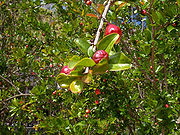
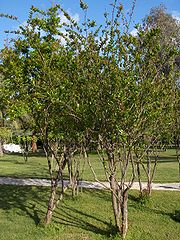
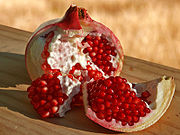
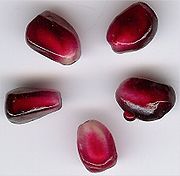
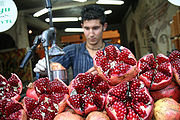
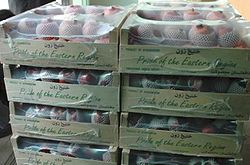
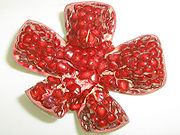
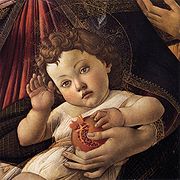





Replies
Hey Ravinder, I can relate to the story really well about the Underworld and Persephone, This story had always caught my attention from the time I had learned about it.
Dead Souls of the Underworld, trying to gain there sight of what there Soul purpose is in life, and even Souls who travel there for there Ascension look on there own life as well.
This really was an interesting myth of time
Bless the Nite,
April
I love pomegranate.... its the best!!!
Thank you! I love this post!
love and light to all
imready : )